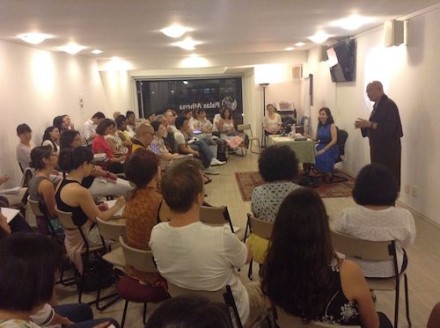BRAZIL: The Tibet House Brazil formally opened its door in Sao Paulo City with a ten-day exhibition of a sand mandala, which beautifully wrapped up on Friday, 25 March.
Many have come from outside Sao Paulo City to have a final glance of the sacred sand mandala before it was dismantled. Considering the presence of significant number of people at the dismantling ceremony, Kusho Losang Samten, who has painstakingly created the Medicine or Healing Buddha Sand Mandala for the past ten days, gave a detail explanation of the mandala once again for the benefit of the onlookers.
Kusho Losang Samten has been living in the United States for 30 years. Before he moved to the United States, he studied at the Namgyal Monastery based in Dharamsala for 20 years and served as a master of ritual dance and sand mandalas at the monastery. He has led an illustrious career creating sacred sand mandalas at various reputed museums, universities, schools, community centers, and galleries throughout the USA, Canada, Mexico, and Europe.
Before Kusho Losang Samten commenced his ritual to dismantle the sand mandala, Soo Kyong Kim, a Korean violinist, offered a very moving musical tribute to the closure of the Sand Mandala exhibition, which brought tears into the eyes of many of the onlookers.
After the completion of the musical tribute, Kusho Losang Samten led the ritual of dismantling the sand mandala and the audience participated in the process of dismantling of the mandala. Thereafter, Kusho collected the sand into a vase and led the procession to throw the sand into the nearby lake at the Ibirapuera Park which is located at the distance of 30 minutes walk. Many have joined procession and the whole event turned out to be very moving and solemn.
For ten days, Kusho Losang Samten has painstakingly created this unique and exquisite art displaying his tremendous artistic skills as well as his vast knowledge of traditional Buddhist iconography. While creating the sand mandala, he carefully explained the onlookers every stage of the Medicine or Healing Buddha Sand Mandala and their significance.
Every aspect of the mandala has meaning and nothing is arbitrary or super-fluent. The colors and designs of each mandala have profound meaning originating in the ancient teachings of the Buddha, and have remained identical to these original teachings over the centuries, with each color being an antidote to specific negative emotions.
Apart from creating the sand mandala, Kusho Losang Samten gave two lectures–one on “Mandala and Its Significance” and second on “Ancient Wisdom for Contemporary Society: Developing a Healthy Mind”. Both his lectures were well attended. The lectures were jointly organized by the Tibet House Brazil and Palas Athena Association and were held at the auditorium of the Palas Athena Association.
He also gave a weekend retreat at Sakya Monastery in Cabreúva in the outskirts of Sao Paulo, an hour long drive from Sao Paulo City to the north. Those who participated in the retreat found it very rewarding and meaningful.
On the whole, the ten-day event turned out to be extremely successful and many have showed interest in attending future events to be held by the Tibet House whether inside the Tibet House premise or outside.
– Report filed by Tibet House, Brazil –



